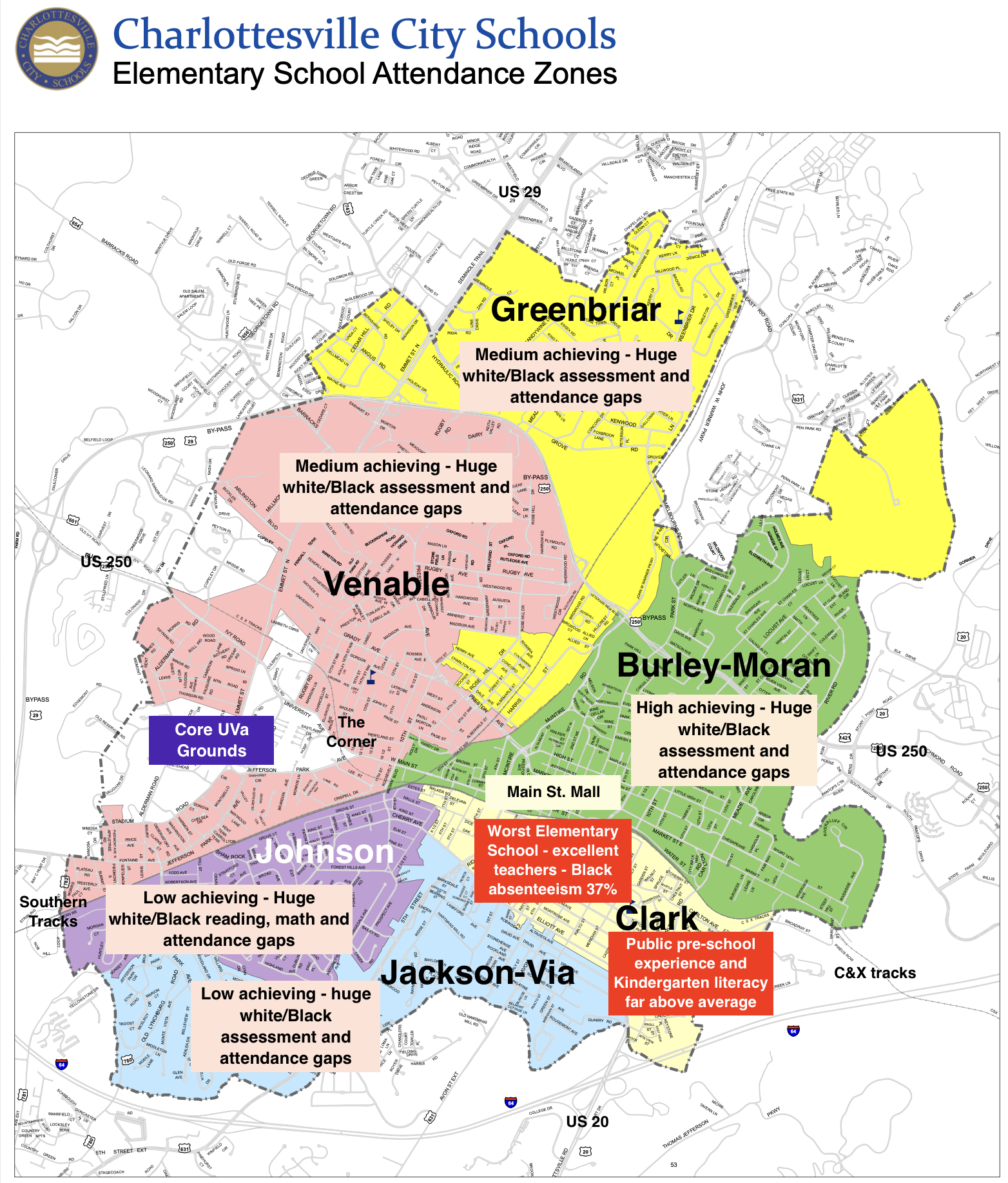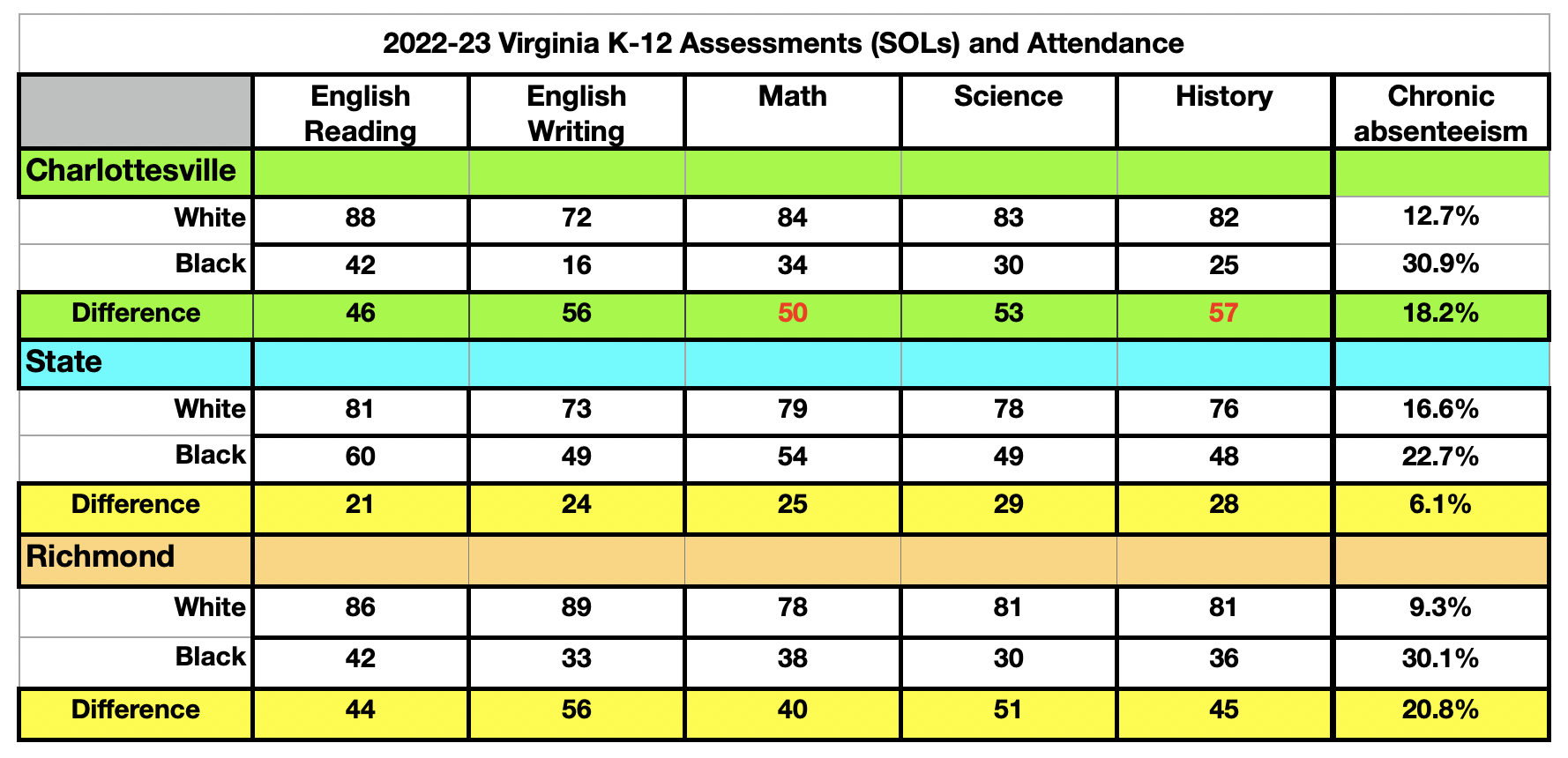by James C. Sherlock
What drew me to this story is the fact that Black students in Charlottesville City Schools (CCS) have suffered to a degree unequaled elsewhere in the Commonwealth.
Keeping in mind the domination of Charlottesville and its schools by the University of Virginia and its School of Education and Human Development discussed in Part One, we will move ahead from there.
CCS is a school system designed unusually with six schools for Pre-K-4, one for grades 5 and 6, another for 7 and 8, and a single high school with a couple of alternative programs.

The map above shows that the Pre-K-4 school boundaries roughly follow the city’s neighborhoods.
Now look at the elementary school performance and attendance annotations.
The biggest anomaly is that the gap between White and Black academic performance in CCS is an ocean. Worse than Richmond both in absolute performance by the Black students and relative to White students.
I can find nowhere in the Commonwealth, including other college towns (and I looked), in which White and Black public-school students exist in academic disparity to the extent they do in Charlottesville.
The Charlottesville High School riots reflect that gulf. Buford Middle is worse.
CCS has managed to fail those Black children in a relatively balanced student demographic of 42% White, 29% Black, 14% Hispanic, 5% Asian and 10% multiple races.
The teachers have far more advanced degrees, most from UVa’s ed school, than the average school division.
It just doesn’t work.
CCS does not enforce truancy laws. Possibly because they think inequitable outcomes would result. Instead they have well-meant but demonstrably failed multi-part strategies to encourage attendance.
There is no effective order and discipline in some of the schools. Same mind set.
So a lot of Black kids have no chance to learn. And the intermittent presence of some makes it harder for teachers to teach.
Those are the inequitable outcomes of unworkable attendance and discipline strategies.
But that is not nearly all they are doing that does not work.
The systems CCS has in place to prevent that very outcome offer a catalog of virtually every equity program that the nation’s schools of education have produced.
Yet that whole effort has failed spectacularly.
All of the outward-facing indicators of a school division that centers equity are there in CCS in both the leadership and policies.
- The division has qualified people in charge. Black professionals are well represented in that leadership. The teachers have higher than usual educational attainment and a statewide average racial mix.
- The usual problems that accompany poverty and single-parent families are there, but neither marker is present at levels seen in most Virginia cities and many poorer counties.
- CCS offers a complex matrix of policies and programs designed to prevent its terrible performance in educating black children.
The very complexity of those policies and programs and their demands on teacher time and academic focus may be part of the problem. But not all of it.
Any attempt to fix Black student achievement must start with improving attendance and providing safe, orderly schools for all kids without which learning cannot occur.
We’ll break down the system as it is.
Infrastructure. The regular schools have been unusually arranged. There are six Pre-K-4 schools, one for grades 5 and 6 (Walker Upper Elementary), one for grades 7 and 8 (Buford Middle), and Charlottesville high school.
There are big changes in the works.
- Buford, to be renamed Charlottesville Middle School when renovations are complete, is being redesigned and expanded to include a sixth grade.
- 5th graders will stay at their elementary schools
- Walker will become a designated early education center.
CCS is a partner in Charlottesville-Albemarle Career and Technical Education Center.
CCS provides alternative education at Lugo-McGinness Academy and offers a hospital education program conducted at UVa Children’s Hospital.
Buford Middle and Charlottesville High (CHS). Note here, because we will talk about discipline and attendance, that Charlottesville High School has gotten recent negative press but Buford Middle School is an absolute nightmare.
The division is accepting considerable risk in bringing 5th graders there.
Buford chronic absenteeism, at 36%, is twice that of the high school and nearly twice the state average. Buford Black student chronic absenteeism last year was 53%, white 26%.
Buford, with less than 600 students in two grades, had 30% of the enrollment of CHS. Yet in descending order of violence of reported offenses last year:
- CHS had the division’s only Behaviors used to determine Persistently Dangerous Schools (violent felony);
- Buford reported 28 Behaviors that Endanger the Health, Safety, or Welfare of Self or Others compared to 47 at CHS; and
- Buford racked up 98 Behaviors of a Safety Concern compared to 61 at the high school.
That is 126 safety-related incidents in a school, Buford, with less than 600 kids, many of whom only attend sporadically. Teacher turnover there is huge.
The high school every year has considerably more 9th graders than the previous year’s Buford 8th grade class primarily because there are several private schools in the area that reach only 8th grade.
There are enough freshman kids at CHS new to the system (last year at least 115 out of 437 9th graders in CHS did not go to Buford the year before) that CHS is whiter and more affluent than Buford.
The Board. School leadership and accountability start with the School Board. So we will.
The Board has seven members. Before the recent elections, four were teachers. Three had connections to UVa. All are elected at large.
Four members did not seek reelection. There were only four candidates to replace them. That is not atypical in Charlottesville local elections.
With the exception of Ms. Richardson, the new Board members have presented themselves as progressives. See their responses to questions about what they will do to address issues such as achievement gaps, school safety and transgender issues.
The word “attendance” does not occur in a 3,300 words of interviews.
The Board sets CCS policy and hires the superintendent. It has recognized two collective bargaining units, Licensed Personnel and School Support Professionals.

The superintendent. Royal A. Gurley, Jr., Ed.D., CCS superintendent since 2021, writes he is
“committed to transformations leadership that prioritizes access and opportunities to learn for all students.”
Just the right tone in my view.
Two years is not a long time to transform large organizations, especially coming out of COVID.
A look at Dr. Gurley’s twitter account shows him to be both engaged and engaging. The Board, which recently extended his contract to 2027, may have the right man for the job.
Races of CCS leadership and teachers. A progressive touchstone in any discussion about Black student success in schools is whether Black professionals have leadership positions in those schools.
Of the thirteen such positions in CCS, eight, including the Superintendent and the principals of the high school and Buford Middle School, are held by Black leaders.
The superintendent, to his credit, has overseen the near-annual “resignations” of the principals of CHS and Buford. I am sure he will choose better.
By contrast, only 12% of the teachers are black. That reflects limited supply rather than lack of major CCS efforts to recruit. The racial mix of CCS teachers reflects those statewide.
Teachers. School year in 2022-23 showed
- Very High Educational Attainment, reflecting proximity to UVa’s School of Education:
- 63% masters degrees compared to 56% statewide;
- 2% Doctoral degrees compared to 1%;
- 4% without college degrees vs. 5%;
- Specific qualifications and experience
- Out-of-field 7.4% – State 6.4%;
- inexperienced 5.8%; – State 5.2%
- both 2.4% – State 1.3%
The differences between CCS teachers and state teachers in specific qualifications and experience are centered in, and explained by, Buford Middle School.
- Out-of Field 26.2%
- Inexperienced 15.4%
- Both 7.7%
Those numbers indicate very high teacher turnover.
Equity and anti-racism. The policeis of CCS that all of those professionals are charged to execute leave no progressive stone unturned.
As example, 86% percent of CCS students in grades 3-11 were identified as gifted in 2021. Only 60% of those students could read and 42% could perform mathematics at grade level in that year.
CCS established an Office of Equity and Engagement in 2018. Lots of equity efforts were in place before then. That Office
“helps ensure the success of all our students.”
CCS defines equity as providing each child what they need to develop, but then writes that working towards equity involves “ensuring equally high outcomes.”
It has an “equity-centered professional learning program.” It boasts family and community engagement, a resource hub for families, multiple community partnerships, and volunteer efforts.
None of those things, however individually worthwhile, have helped Black students succeed.
By its anti-racism policy:
“CCS is committed to altering systemic power and privilege dynamics and structures in order to hear and elevate underrepresented voices and to recognize and eliminate bias.”
The evidence suggests the division has achieved that goal. Black men and women dominate CCS leadership.
But neither the equity and anti-racism policies nor the personnel appointments have improved Black student achievement and attendance. They are still awful.
The problem must lie elsewhere.
Next. In the next article in this series, we will delve deeper into CCS policies on discipline and attendance.
And we will examine the historically close relationship between CCS and the UVa School of Education and Human Development.
The state has thrown $100 million this year at college and university lab schools. UVa’s initiative is at Buford.
“The plan centers on robust professional learning, real-life application of computer science skills, and the latest research on youth development.”
Excellent news for some kids.
But of the 177 Black kids in Buford last year, only 41% could read and 30% could solve math problems at grade level.
A state-of-the-art computer lab may not have been the first thing they needed.
Someone with a high tolerance for chaos will have to teach in it.
A major update was entered on Dec. 18, 2023 to reflect updates in the book version of this series. Some of the text originally in Part One was moved to this Part 2.


Leave a Reply
You must be logged in to post a comment.